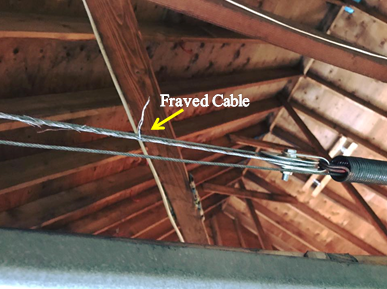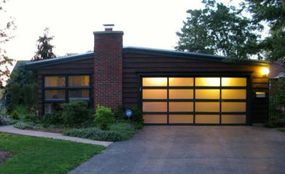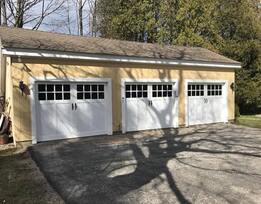|
Garage door motors are not meant to do any hard work. It is merely there to guide the door up and down. The garage door parts are responsible for the heavy lifting and as long as the garage door is balanced and the parts are working at their optimal function, the garage door motor will incur little wear and tear . However, over time, the door parts start to weaken, the tracks may collect debris, or the homeowner does not maintain the door's parts, and so now the door is not functioning well and loses its balance. To make up for the lack of function, the motor starts to work harder causing it to wear out faster.
So do you have to replace the doors? We recommend it if your door is old, has not been maintained, is not balanced, or too heavy for the motors you will be installing.
0 Comments
Keeping your garage door balanced is very crucial to making sure all of its parts are doing their job. An unbalanced garage door causes stress on the garage door parts thus wearing out the garage door opener gears.
If your garage door accessories are not working then you may want to look at your garage door opener sensors. Garage Door sensors have been mandated since 1992 and to be in compliance, they must be installed at about 6 inches from the ground. The sensors ensure the door will not close when there is an object in the way. So how do you spot inoperable sensors?
1. LED light function. One should be yellow/orange/red and one would be green. If the lights are not on, then adjust the sensors slightly. Once the eye beams have met each other, both lights will turn on. Tighten the bracket that holds sensor in place to ensure it does not move again. 2. Check wires running from the garage door opener sensors to the opener. Check to make sure the wires going from the opener unit to the sensors have not been pinched by a staple (typically staples are used by contractors to attach the wire to the wall) 3. Reset the opener. Sometimes resetting the motor will wake up all the accessories and parts. Unplug the motor and let it sit for about 30 min. Plug it back in. 4. Check the wall button. Many times the wall control unit may indicate what is wrong with you opener using codes. Refer to your manual for more information. However, you can use the wall button to try and override the sensor's safety feature. Press and hold the wall button down to see if the door operates. If it does, then you may need new sensors or they may need adjusting. Why does your garage door close in the morning without a problem but not in the afternoon? Or maybe the opposite is true and your garage door doesn't close in the morning but has no trouble in the afternoon. If you have exhausted the obvious reasons like
1. making sure nothing is obstructing your sensors field of contact, 2. making sure the sensors are tightly screwed on and do not wiggle, or 3. using different accessories to open and close during both times of the day Then pay attention to how the sunlight beams at your sensors. Sunlight can interfere with the sensor eyes coming into contact with each other. Check with your manufacturer's instruction on how to combat sunlight that's hitting your sensors. Typically the manufacturers provide a shield of some sort without interfering with the sensor's beam. Many times we get asked, how long does a garage door spring last? There are many factors that cause garage door springs to break.
Lets start with a perfectly balanced garage door with all parts moving in sync and in new condition. A standard spring built for 10,000 cycles should last about 13 years if used at 2 cycles per day. Most people use there door more than two cycles a day, especially if you park your car in there. So let's say if you run 4 cycles a day you are down to about 6-7 years. Now lets say if you have an older door with some other parts that may not be worn out but are a few years old at the time your replace your springs.. A garage door part, like cables for instance, that are not at their 100% functioning ability put a bit more strain on the springs to pick up their work. That is also a factor when determining how long springs should last. We always tell customers expect about 7-10 years. If you want more time out of your springs and use your garage door more than 2 cycles a day, look for higher cycle springs if applicable.  Garage door cables lift the door and counter balance the springs. In an extension spring system, they run on pulleys and in a torsion spring system they roll into a drum at the top of the door. There are many reasons garage door cables break but a here a few common ones. 1. Cables are rubbing against the track or other garage door hardware. 2. Moisture caused the cable to rust. Usually, moisture occurs at the bottom where water from rain or snow seeps in the garage. However, if you leave the door open during these weather events, the cable can rust anywhere. 3. The pulley could be splitting somewhere and causing the cable to fray. Invest in cast iron pulleys which are resistant to splitting. CAUTION: Garage doors are a very big moving object and their parts balance each other out so that minimal work is required while moving. When one of the garage door parts break, it changes the system. If you try to lift the garage door while the parts are broken, you could be causing injury to yourself or damaging the other garage doors parts. We get phone calls often asking what type of garage door services do we do in CT. In all the towns we service like Cheshire, Bristol, Wolcott, Berlin, Newington, Naugatuck, and more, we do the following:
1. Remove old door and install a new one 2. Remove old opener and install a new one 3. Attach an existing opener to a new door. 4. Replace garage door parts like rollers, pulleys, springs, cables, and brackets. 5. Replace opener parts like gears, keypads, remotes, wall buttons, and safety sensors. 6. Make adjustment to existing motors like adjusting vertical limits and force. 7. Make adjustments to garage door balance. 8. Replace garage door weather seal. 9. Wood frame work for garage door support. 10. Install or make adjustments to current garage door supports. We do NOT do the following: 1. Paint doors. 2. Remove dents 3. Flashing around the garage door. There could be a few reasons why you have to hold down the wall control button to close your garage door but the easiest one to rule out is misaligned safety sensors.
When you hold down the button on the control panel, you are overriding the safety feature and telling the opener no matter what is in the way just close the door. Here are a few things to look for when checking the sensors: 1. Clean the sensor's lens and make sure dust, webs, and other debris is not obstructing the lens view. 2. If there are objects around the sensors that you move in an out of the garage (i.e. shovels in the winter, rakes in the summer) put them elsewhere. You may unknowingly hit the sensors and knock it out of alignment. 3.. Most, if not all, sensors have an indicator light that tells you they are functioning. One is usually green and one is red/orange. If one or both are not lit, adjust the sensors (one or both) until the lights come on. Then tightly fasten the bracket screw to make sure the sensors are secured in place. If that doesn't fix your problem, call a garage door service company for further diagnostics. You've had your garage door motor, a LiftMaster Battery-backup, installed for a while. All of a sudden it's starting to beep constantly. What happened? A beeping opener is an indication that the motor is running from the battery source and not your power outlet. We see this a lot after major storms that involve lightening. The most common source of the problem we have come across is that the outlet where the opener is plugged into has died. You can do a few things to test this.
1. Unplug the motor from one side of the outlet and plug it into the other. 2. Plug the motor cord into an extension cord and plug the extension cord to an outlet in a different part of the garage. 3. Use an extension cord to plug a different electronic to the outlet that the motor is originally plugged into and see if that electronic works. These steps will be able to uncover what the source of the problem is. If there is something wrong with the motor, call your installer or if you installed it yourself call the manufacturer's customer service. If your outlet has gone bad, call an electrician. So you have decided that fixing the garage door isn't worth it and you are going to order a completely new system. Congratulations! So now you have to determine which door, of the thousands out there, are right for you. But how? Here, scenario A, is how most of our customers start deciding on the door they want: 1. Design 2. Budget And then here, Scenario B, is how it actually ends up: 1. Budget 2. Design But what if you have come across two garage doors (fairly comparable in many specs) and you are really struggling with making a decision? What do you do? We help customers break down the options they are looking into and although each situation is a little different, generally here is what we tell them.
Many times customers have had an 'aha' moment using this a guide to help them through the process and I hope it helps you too.
Many parts play a factor in making your garage door quieter. Here are few solutions to look into.
Upgrading your hardware such as using nylon rollers instead of steel rollers can help reduce noise because it will eliminate the steel roller on steel tracks friction. Lubricate all of the parts to help reduce squeaking springs, cables, rollers, pulleys, etc. Make sure all of the nuts and bolts are tightly wound. Any rusted hinges, brackets, moving parts, etc should be replaced. The condition and mechanism of your garage door opener should also be looked into. Belt driven garage door openers are much quieter than chain driven openers. If you want a very quiet opener, look into Liftmaster's Side Mount but you need to have a torsion spring system set up for that. If you want to hear what the same motor sounds like on different door types visit our OPENERS IN ACTION page. We get asked all the time about why the bigger companies charge less. Because they can (they buy in bulk).
Think about what you are not getting from them that you can get from a smaller garage door company like Absolute Garage Doors: 1. Accountability: When an owner of his company performs his services, he does it with care because now you know him. If his services don't meet your standards he takes full responsibility for it. 2. Availability: Smaller company equals less customers. Less customers equal better chances you will get a service scheduled same day. 3. Empathy: We get it! Small business owners have spent their own money and countless hours to make their business grow successfully and it's all because we have families to support. So we understand you have a budget and you don't want to be taken advantage of. Small business owners don't need to ask supervisors for permission to provide discounts. So you may be paying a little more money to a small business owner rather than a Home Depot but you get more than what they can give you. Absolutely! Extension springs (located on either side of the door) need to work together and in sync in order for your door to run smoothly. If one is pulling too much and the other not enough the door will wobble or not go up and down at all. Unless you truly know what you are doing, DO NOT attempt to change you springs yourself. Springs (extension or torsion) hold an enormous amount of tension and one mistake can cause bodily harm.
Garage doors will never run silently. There is a difference however, in a little noise from a running motor or parts and something that sounds like the house is coming down. Here are a few things consider:
1. Over time many garage doors just need a tune-up or lubricating parts to release the friction. Spray the moving parts such as rollers. 2.Some parts like nuts and bolts may wear out and need replacing. Looking for loose bolts will give this away. 3. If you have a garage door motor that runs your door, look for chain or belts off track. Do I have to call a professional? While we will always come to your aid, sometimes inspecting, lubricating, and tightening nuts and bolts yourself makes more budget sense. If you think any parts need to be replaced, that might be best left to a professional like us! Garage doors are under high tension and can cause bodily harm if not handled properly. When in doubt - REMEMBER WE OFFER FREE IN HOME ESTIMATES! Common reasons garage door won't open.
1. Safety Sensors - An absolute must when your door is operated by a motor is having some sort of safety sensors installed. Typically these look like small cameras with a lens that must face each other in order to work properly. They are installed about 6 inches from the ground on either side of the garage door.
Safety Commission has posted official regulations here: http://www.cpsc.gov/en/Newsroom/News-Releases/1993/Safety-Commission-Publishes-Final-Rules-For-Automatic-Garage-Door-Openers/ 2. Lock the door and use the motor? - NEVER! So many homeowners ask to have a lock installed on a garage door that has a garage door motor installed. Although against our recommendation we do as the customer wants. We also tell them that adding a lock can become a big future expense. How? I can't tell you many times in the past years homeowners have forgotten that they locked the garage door and then used the motor to open door. What happened? The garage door panel dented. If the panel has glass, the glass can break. Bottom line, a lock is not needed when you have a motor. If you must have one. Place something over the garage door remotes, keypads, or wall buttons to remind you to unlock the door first. 3. Maintenance is key - Regularly inspect your garage door tracks, springs, cables, and other moving parts. Look for loose hinges and damaged or deteriorating parts. If you have a wood door, annual paint/stain maintenance is a must to avoid any rotting panels. 4. What NOT to use - Part of maintaining your garage door is lubrication of parts. Contrary to popular belief WD40 is NOT a lubricant and should NOT be used on your doors. Most hardware stores carry products such as a light motor oil or a non-silicon based lubricant. In torsion spring systems, cables are attached to the brackets at the bottom of the door. The cables are attached to the drums at the top of the door and when the door is raised, the cables wind onto the drums.
In extension spring systems, the cables are part of the pulley system. Cables help both side of your door stay in balance as it moves up and down. It is crucial that cables are running in sync so that other parts do not get damaged. Furthermore, because these parts are under high tension, please have a door professional take care of this repair. |
Helpful Garage Door DIY repairs and FAQsAuthorMia is the customer service coordinator. She answers all questions regarding accounts, products, services, and the blog. Archives
March 2020
Categories
All
Call for professional garage door repair!
|
Services |
Company |
|







 RSS Feed
RSS Feed